Gender's Role in Shaping Helping Behavior: A Psychology Assignment
VerifiedAdded on 2021/04/17
|6
|1480
|58
Essay
AI Summary
This essay examines the multifaceted role of gender in influencing helping behavior, particularly within Western societies. It explores gender differences in helping strangers, the impact of societal norms and gender roles, and the influence of physical attractiveness and social status. The essay discusses how gender schema theory and social role theory shape helping behavior, highlighting the differences between masculine and feminine approaches. Furthermore, it identifies a gap in the existing literature concerning the role of cross-gender interactions in helping behavior and the experiences of transgender individuals. The essay draws upon various research papers and studies to support its arguments, providing a comprehensive overview of the topic. It emphasizes the complex interplay between gender, societal expectations, and individual actions in shaping prosocial behavior. The findings suggest that gender plays a significant role in helping behavior, influencing both who offers help and who receives it, while also acknowledging the need for further research in this area.
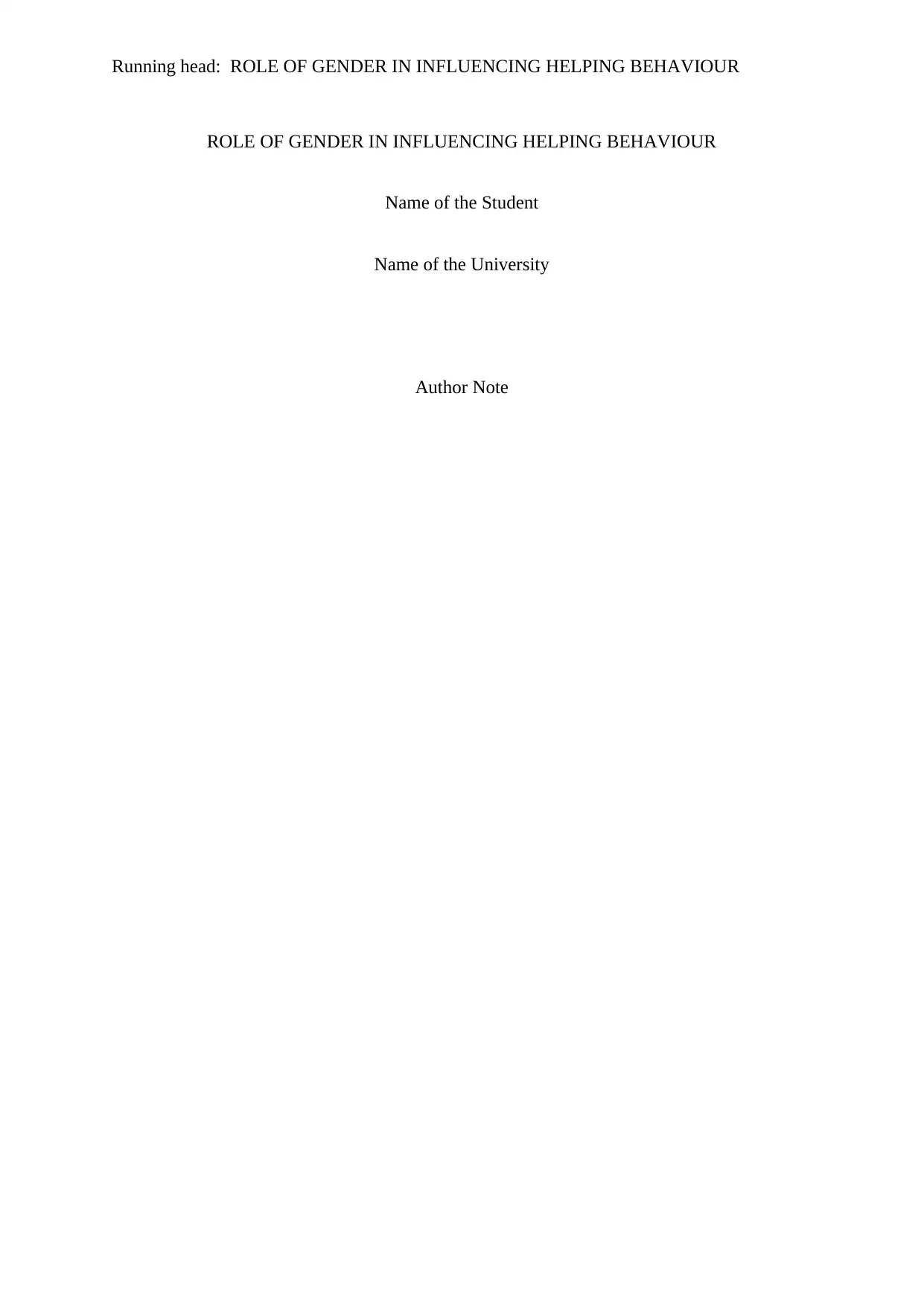
Running head: ROLE OF GENDER IN INFLUENCING HELPING BEHAVIOUR
ROLE OF GENDER IN INFLUENCING HELPING BEHAVIOUR
Name of the Student
Name of the University
Author Note
ROLE OF GENDER IN INFLUENCING HELPING BEHAVIOUR
Name of the Student
Name of the University
Author Note
Paraphrase This Document
Need a fresh take? Get an instant paraphrase of this document with our AI Paraphraser
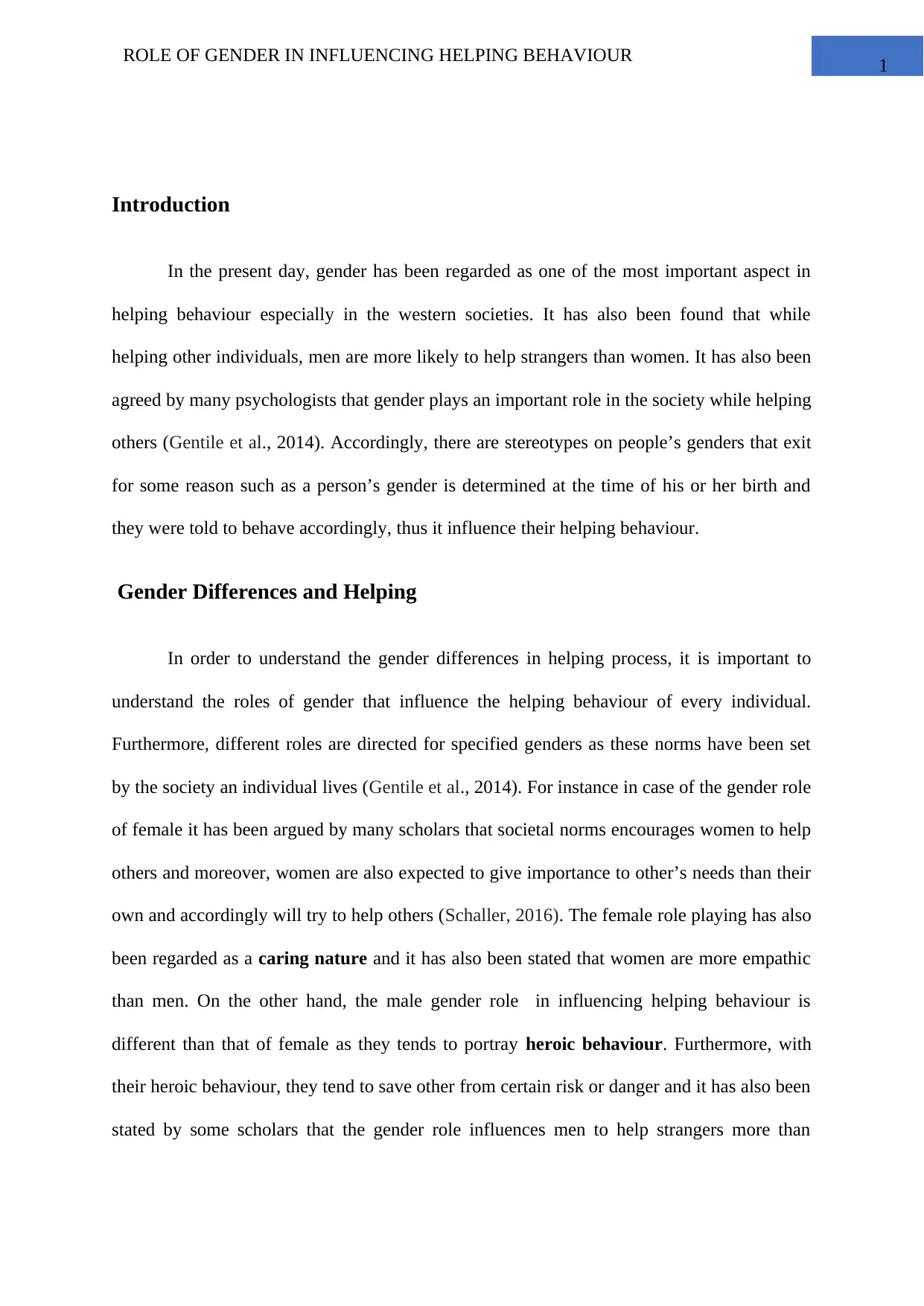
1
ROLE OF GENDER IN INFLUENCING HELPING BEHAVIOUR
Introduction
In the present day, gender has been regarded as one of the most important aspect in
helping behaviour especially in the western societies. It has also been found that while
helping other individuals, men are more likely to help strangers than women. It has also been
agreed by many psychologists that gender plays an important role in the society while helping
others (Gentile et al., 2014). Accordingly, there are stereotypes on people’s genders that exit
for some reason such as a person’s gender is determined at the time of his or her birth and
they were told to behave accordingly, thus it influence their helping behaviour.
Gender Differences and Helping
In order to understand the gender differences in helping process, it is important to
understand the roles of gender that influence the helping behaviour of every individual.
Furthermore, different roles are directed for specified genders as these norms have been set
by the society an individual lives (Gentile et al., 2014). For instance in case of the gender role
of female it has been argued by many scholars that societal norms encourages women to help
others and moreover, women are also expected to give importance to other’s needs than their
own and accordingly will try to help others (Schaller, 2016). The female role playing has also
been regarded as a caring nature and it has also been stated that women are more empathic
than men. On the other hand, the male gender role in influencing helping behaviour is
different than that of female as they tends to portray heroic behaviour. Furthermore, with
their heroic behaviour, they tend to save other from certain risk or danger and it has also been
stated by some scholars that the gender role influences men to help strangers more than
ROLE OF GENDER IN INFLUENCING HELPING BEHAVIOUR
Introduction
In the present day, gender has been regarded as one of the most important aspect in
helping behaviour especially in the western societies. It has also been found that while
helping other individuals, men are more likely to help strangers than women. It has also been
agreed by many psychologists that gender plays an important role in the society while helping
others (Gentile et al., 2014). Accordingly, there are stereotypes on people’s genders that exit
for some reason such as a person’s gender is determined at the time of his or her birth and
they were told to behave accordingly, thus it influence their helping behaviour.
Gender Differences and Helping
In order to understand the gender differences in helping process, it is important to
understand the roles of gender that influence the helping behaviour of every individual.
Furthermore, different roles are directed for specified genders as these norms have been set
by the society an individual lives (Gentile et al., 2014). For instance in case of the gender role
of female it has been argued by many scholars that societal norms encourages women to help
others and moreover, women are also expected to give importance to other’s needs than their
own and accordingly will try to help others (Schaller, 2016). The female role playing has also
been regarded as a caring nature and it has also been stated that women are more empathic
than men. On the other hand, the male gender role in influencing helping behaviour is
different than that of female as they tends to portray heroic behaviour. Furthermore, with
their heroic behaviour, they tend to save other from certain risk or danger and it has also been
stated by some scholars that the gender role influences men to help strangers more than
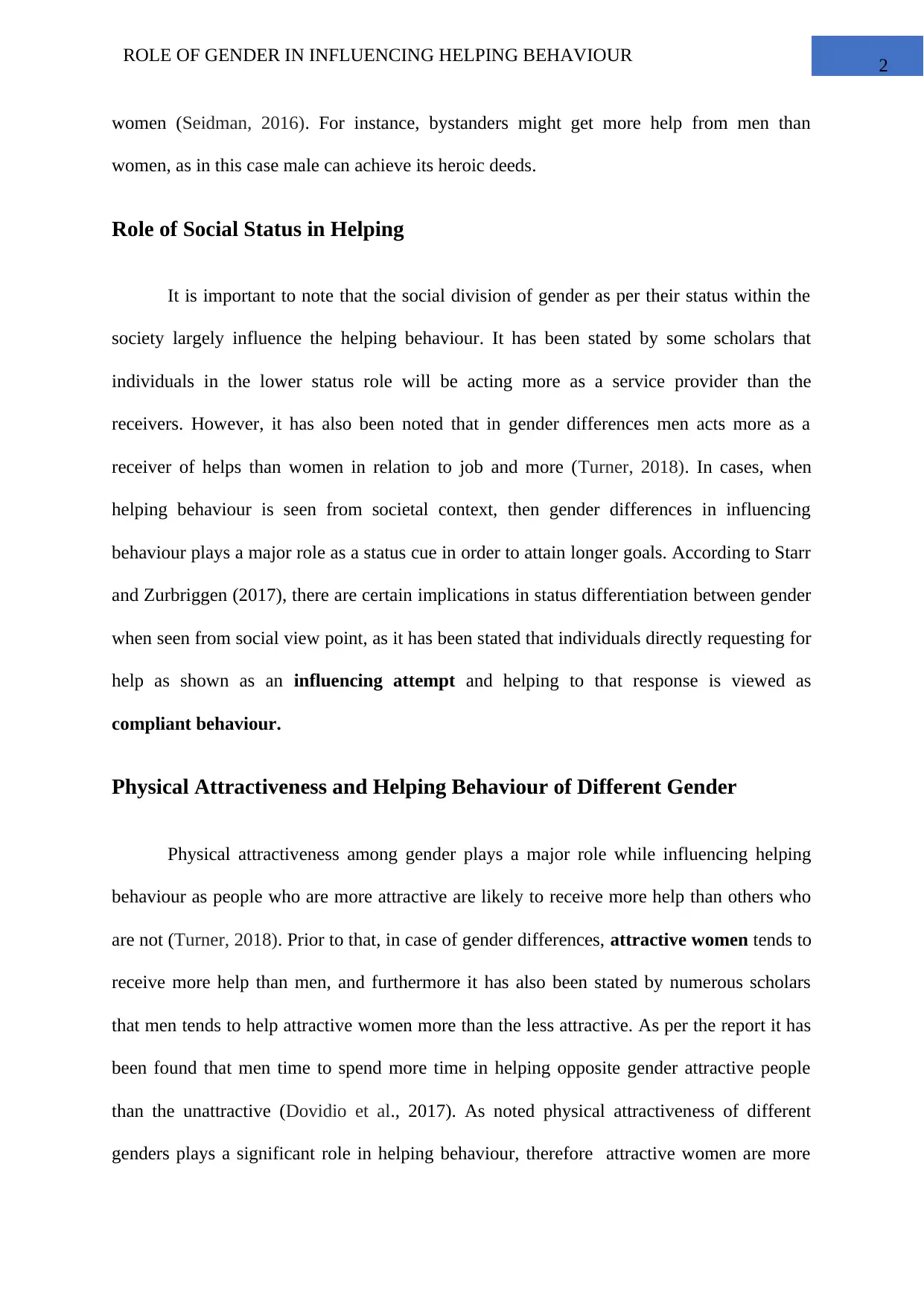
2
ROLE OF GENDER IN INFLUENCING HELPING BEHAVIOUR
women (Seidman, 2016). For instance, bystanders might get more help from men than
women, as in this case male can achieve its heroic deeds.
Role of Social Status in Helping
It is important to note that the social division of gender as per their status within the
society largely influence the helping behaviour. It has been stated by some scholars that
individuals in the lower status role will be acting more as a service provider than the
receivers. However, it has also been noted that in gender differences men acts more as a
receiver of helps than women in relation to job and more (Turner, 2018). In cases, when
helping behaviour is seen from societal context, then gender differences in influencing
behaviour plays a major role as a status cue in order to attain longer goals. According to Starr
and Zurbriggen (2017), there are certain implications in status differentiation between gender
when seen from social view point, as it has been stated that individuals directly requesting for
help as shown as an influencing attempt and helping to that response is viewed as
compliant behaviour.
Physical Attractiveness and Helping Behaviour of Different Gender
Physical attractiveness among gender plays a major role while influencing helping
behaviour as people who are more attractive are likely to receive more help than others who
are not (Turner, 2018). Prior to that, in case of gender differences, attractive women tends to
receive more help than men, and furthermore it has also been stated by numerous scholars
that men tends to help attractive women more than the less attractive. As per the report it has
been found that men time to spend more time in helping opposite gender attractive people
than the unattractive (Dovidio et al., 2017). As noted physical attractiveness of different
genders plays a significant role in helping behaviour, therefore attractive women are more
ROLE OF GENDER IN INFLUENCING HELPING BEHAVIOUR
women (Seidman, 2016). For instance, bystanders might get more help from men than
women, as in this case male can achieve its heroic deeds.
Role of Social Status in Helping
It is important to note that the social division of gender as per their status within the
society largely influence the helping behaviour. It has been stated by some scholars that
individuals in the lower status role will be acting more as a service provider than the
receivers. However, it has also been noted that in gender differences men acts more as a
receiver of helps than women in relation to job and more (Turner, 2018). In cases, when
helping behaviour is seen from societal context, then gender differences in influencing
behaviour plays a major role as a status cue in order to attain longer goals. According to Starr
and Zurbriggen (2017), there are certain implications in status differentiation between gender
when seen from social view point, as it has been stated that individuals directly requesting for
help as shown as an influencing attempt and helping to that response is viewed as
compliant behaviour.
Physical Attractiveness and Helping Behaviour of Different Gender
Physical attractiveness among gender plays a major role while influencing helping
behaviour as people who are more attractive are likely to receive more help than others who
are not (Turner, 2018). Prior to that, in case of gender differences, attractive women tends to
receive more help than men, and furthermore it has also been stated by numerous scholars
that men tends to help attractive women more than the less attractive. As per the report it has
been found that men time to spend more time in helping opposite gender attractive people
than the unattractive (Dovidio et al., 2017). As noted physical attractiveness of different
genders plays a significant role in helping behaviour, therefore attractive women are more
⊘ This is a preview!⊘
Do you want full access?
Subscribe today to unlock all pages.

Trusted by 1+ million students worldwide
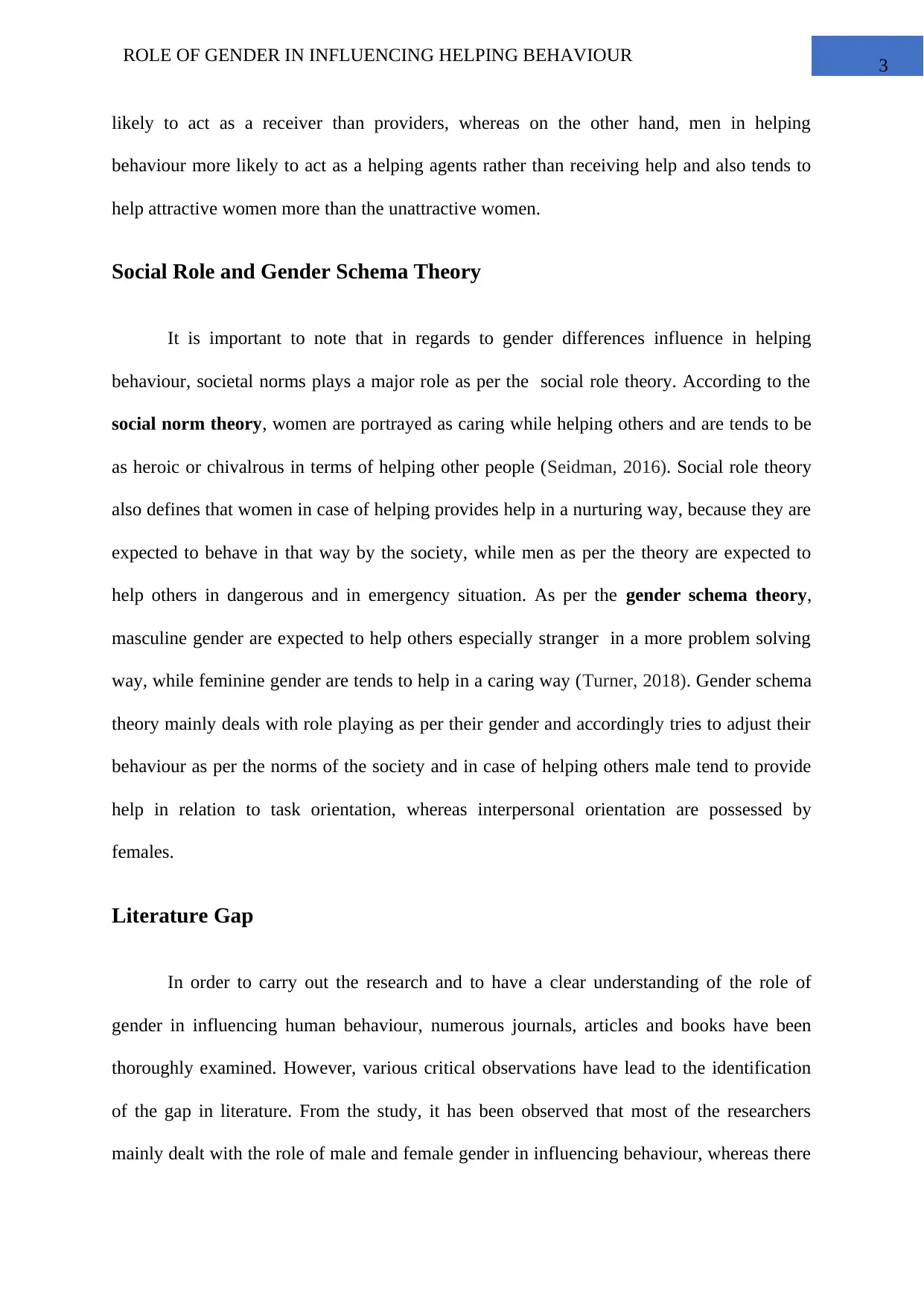
3
ROLE OF GENDER IN INFLUENCING HELPING BEHAVIOUR
likely to act as a receiver than providers, whereas on the other hand, men in helping
behaviour more likely to act as a helping agents rather than receiving help and also tends to
help attractive women more than the unattractive women.
Social Role and Gender Schema Theory
It is important to note that in regards to gender differences influence in helping
behaviour, societal norms plays a major role as per the social role theory. According to the
social norm theory, women are portrayed as caring while helping others and are tends to be
as heroic or chivalrous in terms of helping other people (Seidman, 2016). Social role theory
also defines that women in case of helping provides help in a nurturing way, because they are
expected to behave in that way by the society, while men as per the theory are expected to
help others in dangerous and in emergency situation. As per the gender schema theory,
masculine gender are expected to help others especially stranger in a more problem solving
way, while feminine gender are tends to help in a caring way (Turner, 2018). Gender schema
theory mainly deals with role playing as per their gender and accordingly tries to adjust their
behaviour as per the norms of the society and in case of helping others male tend to provide
help in relation to task orientation, whereas interpersonal orientation are possessed by
females.
Literature Gap
In order to carry out the research and to have a clear understanding of the role of
gender in influencing human behaviour, numerous journals, articles and books have been
thoroughly examined. However, various critical observations have lead to the identification
of the gap in literature. From the study, it has been observed that most of the researchers
mainly dealt with the role of male and female gender in influencing behaviour, whereas there
ROLE OF GENDER IN INFLUENCING HELPING BEHAVIOUR
likely to act as a receiver than providers, whereas on the other hand, men in helping
behaviour more likely to act as a helping agents rather than receiving help and also tends to
help attractive women more than the unattractive women.
Social Role and Gender Schema Theory
It is important to note that in regards to gender differences influence in helping
behaviour, societal norms plays a major role as per the social role theory. According to the
social norm theory, women are portrayed as caring while helping others and are tends to be
as heroic or chivalrous in terms of helping other people (Seidman, 2016). Social role theory
also defines that women in case of helping provides help in a nurturing way, because they are
expected to behave in that way by the society, while men as per the theory are expected to
help others in dangerous and in emergency situation. As per the gender schema theory,
masculine gender are expected to help others especially stranger in a more problem solving
way, while feminine gender are tends to help in a caring way (Turner, 2018). Gender schema
theory mainly deals with role playing as per their gender and accordingly tries to adjust their
behaviour as per the norms of the society and in case of helping others male tend to provide
help in relation to task orientation, whereas interpersonal orientation are possessed by
females.
Literature Gap
In order to carry out the research and to have a clear understanding of the role of
gender in influencing human behaviour, numerous journals, articles and books have been
thoroughly examined. However, various critical observations have lead to the identification
of the gap in literature. From the study, it has been observed that most of the researchers
mainly dealt with the role of male and female gender in influencing behaviour, whereas there
Paraphrase This Document
Need a fresh take? Get an instant paraphrase of this document with our AI Paraphraser
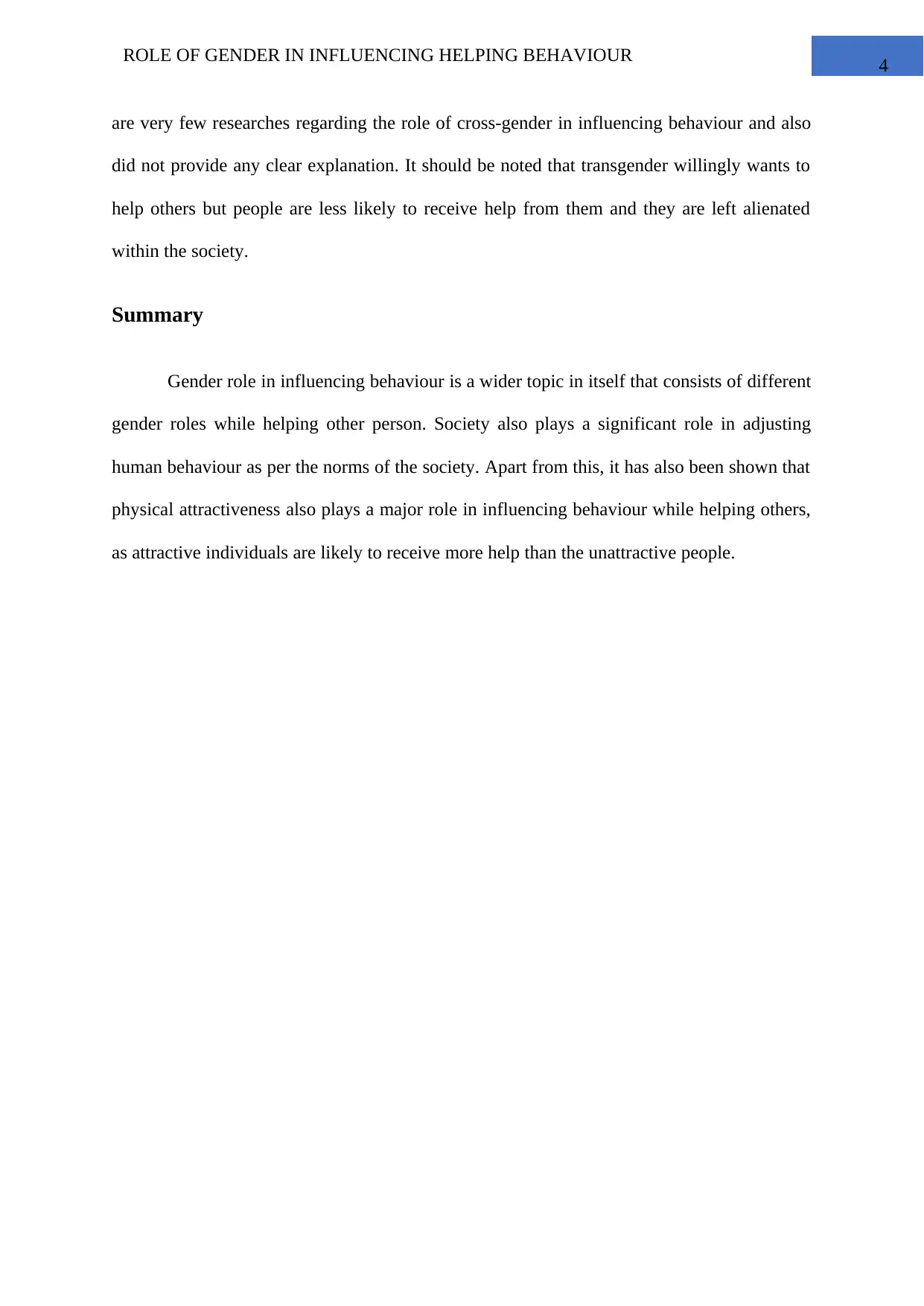
4
ROLE OF GENDER IN INFLUENCING HELPING BEHAVIOUR
are very few researches regarding the role of cross-gender in influencing behaviour and also
did not provide any clear explanation. It should be noted that transgender willingly wants to
help others but people are less likely to receive help from them and they are left alienated
within the society.
Summary
Gender role in influencing behaviour is a wider topic in itself that consists of different
gender roles while helping other person. Society also plays a significant role in adjusting
human behaviour as per the norms of the society. Apart from this, it has also been shown that
physical attractiveness also plays a major role in influencing behaviour while helping others,
as attractive individuals are likely to receive more help than the unattractive people.
ROLE OF GENDER IN INFLUENCING HELPING BEHAVIOUR
are very few researches regarding the role of cross-gender in influencing behaviour and also
did not provide any clear explanation. It should be noted that transgender willingly wants to
help others but people are less likely to receive help from them and they are left alienated
within the society.
Summary
Gender role in influencing behaviour is a wider topic in itself that consists of different
gender roles while helping other person. Society also plays a significant role in adjusting
human behaviour as per the norms of the society. Apart from this, it has also been shown that
physical attractiveness also plays a major role in influencing behaviour while helping others,
as attractive individuals are likely to receive more help than the unattractive people.
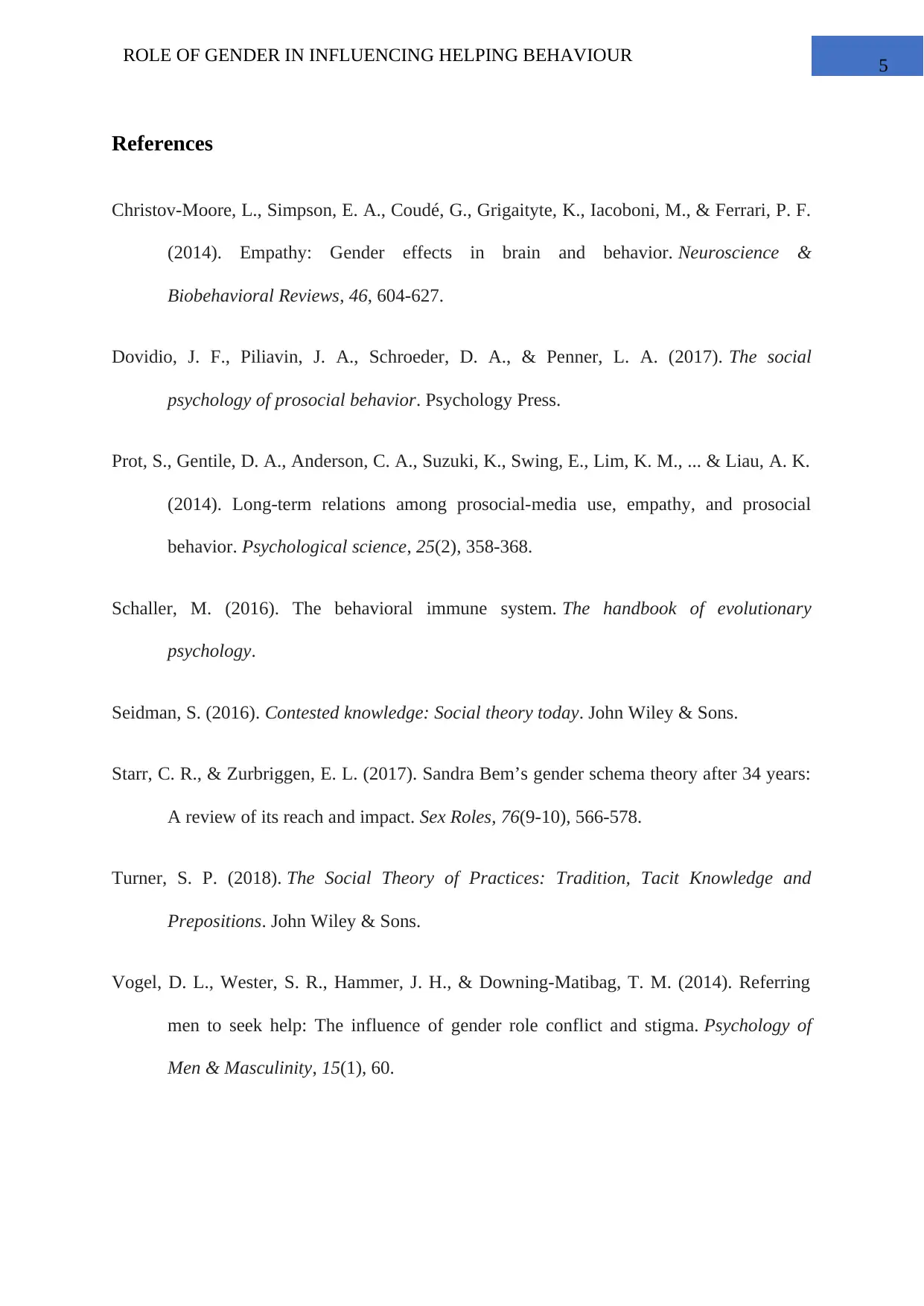
5
ROLE OF GENDER IN INFLUENCING HELPING BEHAVIOUR
References
Christov-Moore, L., Simpson, E. A., Coudé, G., Grigaityte, K., Iacoboni, M., & Ferrari, P. F.
(2014). Empathy: Gender effects in brain and behavior. Neuroscience &
Biobehavioral Reviews, 46, 604-627.
Dovidio, J. F., Piliavin, J. A., Schroeder, D. A., & Penner, L. A. (2017). The social
psychology of prosocial behavior. Psychology Press.
Prot, S., Gentile, D. A., Anderson, C. A., Suzuki, K., Swing, E., Lim, K. M., ... & Liau, A. K.
(2014). Long-term relations among prosocial-media use, empathy, and prosocial
behavior. Psychological science, 25(2), 358-368.
Schaller, M. (2016). The behavioral immune system. The handbook of evolutionary
psychology.
Seidman, S. (2016). Contested knowledge: Social theory today. John Wiley & Sons.
Starr, C. R., & Zurbriggen, E. L. (2017). Sandra Bem’s gender schema theory after 34 years:
A review of its reach and impact. Sex Roles, 76(9-10), 566-578.
Turner, S. P. (2018). The Social Theory of Practices: Tradition, Tacit Knowledge and
Prepositions. John Wiley & Sons.
Vogel, D. L., Wester, S. R., Hammer, J. H., & Downing-Matibag, T. M. (2014). Referring
men to seek help: The influence of gender role conflict and stigma. Psychology of
Men & Masculinity, 15(1), 60.
ROLE OF GENDER IN INFLUENCING HELPING BEHAVIOUR
References
Christov-Moore, L., Simpson, E. A., Coudé, G., Grigaityte, K., Iacoboni, M., & Ferrari, P. F.
(2014). Empathy: Gender effects in brain and behavior. Neuroscience &
Biobehavioral Reviews, 46, 604-627.
Dovidio, J. F., Piliavin, J. A., Schroeder, D. A., & Penner, L. A. (2017). The social
psychology of prosocial behavior. Psychology Press.
Prot, S., Gentile, D. A., Anderson, C. A., Suzuki, K., Swing, E., Lim, K. M., ... & Liau, A. K.
(2014). Long-term relations among prosocial-media use, empathy, and prosocial
behavior. Psychological science, 25(2), 358-368.
Schaller, M. (2016). The behavioral immune system. The handbook of evolutionary
psychology.
Seidman, S. (2016). Contested knowledge: Social theory today. John Wiley & Sons.
Starr, C. R., & Zurbriggen, E. L. (2017). Sandra Bem’s gender schema theory after 34 years:
A review of its reach and impact. Sex Roles, 76(9-10), 566-578.
Turner, S. P. (2018). The Social Theory of Practices: Tradition, Tacit Knowledge and
Prepositions. John Wiley & Sons.
Vogel, D. L., Wester, S. R., Hammer, J. H., & Downing-Matibag, T. M. (2014). Referring
men to seek help: The influence of gender role conflict and stigma. Psychology of
Men & Masculinity, 15(1), 60.
⊘ This is a preview!⊘
Do you want full access?
Subscribe today to unlock all pages.

Trusted by 1+ million students worldwide
1 out of 6
Related Documents
Your All-in-One AI-Powered Toolkit for Academic Success.
+13062052269
info@desklib.com
Available 24*7 on WhatsApp / Email
![[object Object]](/_next/static/media/star-bottom.7253800d.svg)
Unlock your academic potential
Copyright © 2020–2025 A2Z Services. All Rights Reserved. Developed and managed by ZUCOL.





